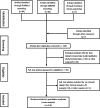The effect of donor human milk on the length of hospital stay in very low birthweight infants: a systematic review and meta-analysis
- PMID: 33115488
- PMCID: PMC7594457
- DOI: 10.1186/s13006-020-00332-6
The effect of donor human milk on the length of hospital stay in very low birthweight infants: a systematic review and meta-analysis
Abstract
Background: Donor human milk (DHM) is an alternative to preterm infant formula if the mother's own milk is not available. Since the lactation period and preservation treatment of DHM are different from those of mother's own milk, we aimed to determine the reduction in the length of hospital stay by DHM compared to preterm infant formula.
Methods: In this systematic review, we searched PubMed/MEDLINE, EMBASE, and the Cochrane Library to retrieve studies on the impact of DHM on the clinical outcomes of preterm infants published before 1 November 2019. The study included very low birthweight (VLBW) infants taking either DHM or infant formula with data on the length of hospital stay. Data were analysed using Review Manager 5.3 software.
Results: The literature search yielded 136 articles, and four randomised controlled trials (RCTs) and eight observational studies met the inclusion criteria. A meta-analysis of the RCTs (N = 725) showed no reduction in the length of hospital stay in both the DHM and infant formula groups (- 0.22 days; 95% CI -6.38, 5.95 days), whereas that of the eight observational studies (N = 2496) showed a significant reduction in the length of hospital stay in the DHM group (- 11.72 days; 95% CI -22.07, - 1.37 days). A subgroup analysis of the RCTs revealed that the incidence of necrotising enterocolitis (NEC) was significantly lower in the DHM group when the analysis included high-quality RCTs (RR = 0.32; 95% CI 0.15, 0.69).
Conclusions: This systematic review of RCTs showed that DHM neither prolonged nor shortened the length of hospital stay in VLBW infants compared to preterm infant formula; however, it reduced the incidence of NEC, further validating the protective role of DHM in the health and safety of VLBW infants.
Keywords: Donor human milk; Length of hospital stay; Preterm infant.
Conflict of interest statement
The authors declare that they have no competing interest.
Figures



Similar articles
-
Continuous nasogastric milk feeding versus intermittent bolus milk feeding for preterm infants less than 1500 grams.Cochrane Database Syst Rev. 2021 Jun 24;6(6):CD001819. doi: 10.1002/14651858.CD001819.pub3. Cochrane Database Syst Rev. 2021. PMID: 34165778 Free PMC article.
-
Individualized versus standard diet fortification for growth and development in preterm infants receiving human milk.Cochrane Database Syst Rev. 2020 Nov 23;11(11):CD013465. doi: 10.1002/14651858.CD013465.pub2. Cochrane Database Syst Rev. 2020. PMID: 33226632 Free PMC article.
-
Protein supplementation of human milk for promoting growth in preterm infants.Cochrane Database Syst Rev. 2020 Sep 23;9(9):CD000433. doi: 10.1002/14651858.CD000433.pub3. Cochrane Database Syst Rev. 2020. PMID: 32964431 Free PMC article.
-
Is Donated Breast Milk Better Than Formula for Feeding Very Low Birth Weight Infants? A Systematic Review and Meta-Analysis.Worldviews Evid Based Nurs. 2019 Dec;16(6):485-494. doi: 10.1111/wvn.12410. Epub 2019 Nov 19. Worldviews Evid Based Nurs. 2019. PMID: 31743577
-
Cost-Effectiveness of Supplemental Donor Milk Versus Formula for Very Low Birth Weight Infants.Pediatrics. 2018 Mar;141(3):e20170737. doi: 10.1542/peds.2017-0737. Pediatrics. 2018. PMID: 29490909 Clinical Trial.
Cited by
-
Short outcomes of donor milk and mother's own milk for preterm infants.Pediatr Res. 2025 Jun 17. doi: 10.1038/s41390-025-04208-5. Online ahead of print. Pediatr Res. 2025. PMID: 40527952
-
Factors Associated with the Prolonged Use of Donor Human Milk at the Da Nang Hospital for Women and Children in Vietnam.Nutrients. 2024 Dec 22;16(24):4402. doi: 10.3390/nu16244402. Nutrients. 2024. PMID: 39771023 Free PMC article.
-
The impact of donating milk on the health of milk donors and their infants: A systematic review and meta-analysis protocol.JPGN Rep. 2024 Jun 24;5(3):347-352. doi: 10.1002/jpr3.12101. eCollection 2024 Aug. JPGN Rep. 2024. PMID: 39149172 Free PMC article.
-
Review highlights the importance of donor human milk being available for very low birth weight infants.Acta Paediatr. 2022 Jun;111(6):1127-1133. doi: 10.1111/apa.16296. Epub 2022 Mar 5. Acta Paediatr. 2022. PMID: 35170785 Free PMC article. Review.
-
Impact of Enteral Nutrition on Clinical Outcomes in Very Low Birth Weight Infants in the NICU: A Single-Center Retrospective Cohort Study.Nutrients. 2025 Mar 25;17(7):1138. doi: 10.3390/nu17071138. Nutrients. 2025. PMID: 40218896 Free PMC article.
References
Publication types
MeSH terms
LinkOut - more resources
Full Text Sources
Miscellaneous

